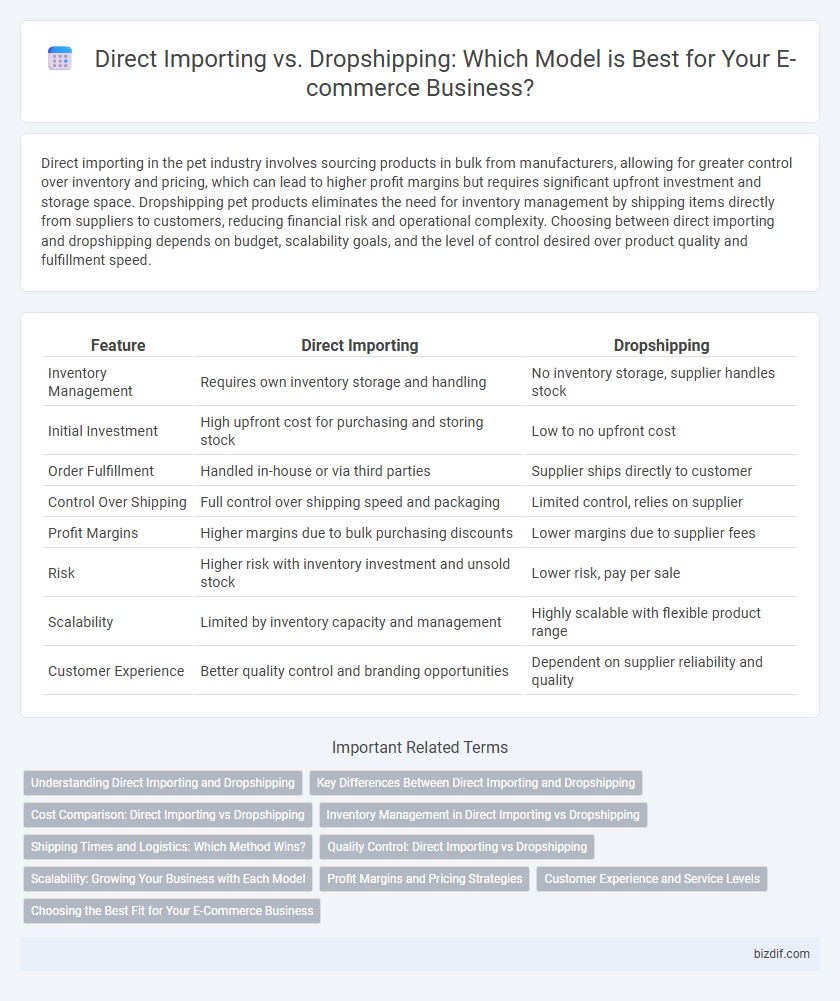Direct importing in the pet industry involves sourcing products in bulk from manufacturers, allowing for greater control over inventory and pricing, which can lead to higher profit margins but requires significant upfront investment and storage space. Dropshipping pet products eliminates the need for inventory management by shipping items directly from suppliers to customers, reducing financial risk and operational complexity. Choosing between direct importing and dropshipping depends on budget, scalability goals, and the level of control desired over product quality and fulfillment speed.
Table of Comparison
| Feature | Direct Importing | Dropshipping |
|---|---|---|
| Inventory Management | Requires own inventory storage and handling | No inventory storage, supplier handles stock |
| Initial Investment | High upfront cost for purchasing and storing stock | Low to no upfront cost |
| Order Fulfillment | Handled in-house or via third parties | Supplier ships directly to customer |
| Control Over Shipping | Full control over shipping speed and packaging | Limited control, relies on supplier |
| Profit Margins | Higher margins due to bulk purchasing discounts | Lower margins due to supplier fees |
| Risk | Higher risk with inventory investment and unsold stock | Lower risk, pay per sale |
| Scalability | Limited by inventory capacity and management | Highly scalable with flexible product range |
| Customer Experience | Better quality control and branding opportunities | Dependent on supplier reliability and quality |
Understanding Direct Importing and Dropshipping
Direct importing involves purchasing products in bulk directly from manufacturers or suppliers and managing inventory, warehousing, and shipping independently. Dropshipping allows retailers to sell products without holding inventory, as suppliers handle storage, packaging, and shipping directly to customers. Understanding these differences helps businesses choose between capital-intensive inventory management and a low-risk, scalable sales model.
Key Differences Between Direct Importing and Dropshipping
Direct importing involves purchasing bulk inventory from manufacturers or suppliers and managing storage, shipping, and fulfillment independently, providing greater control over product quality and shipping times. Dropshipping eliminates the need for inventory management by partnering with suppliers who handle product storage and direct shipping to customers, reducing upfront costs but potentially sacrificing control over fulfillment speed and stock availability. Key differences include inventory ownership, capital investment, and fulfillment responsibility, with direct importing requiring substantial investment and dropshipping offering flexibility and lower risk for new entrepreneurs.
Cost Comparison: Direct Importing vs Dropshipping
Direct importing requires significant upfront investment due to bulk purchasing, shipping, customs fees, and warehousing costs, increasing overall operational expenses. Dropshipping minimizes initial costs by eliminating inventory holding and upfront product purchasing, relying on suppliers to fulfill orders directly. Evaluating total cost of ownership, dropshipping offers lower financial risk and reduced capital requirements compared to direct importing, but may have higher per-unit prices.
Inventory Management in Direct Importing vs Dropshipping
Direct importing requires substantial inventory management, including stock purchasing, warehousing, and handling logistics, which increases overhead costs and risks of unsold inventory. Dropshipping eliminates the need for inventory storage by allowing sellers to transfer customer orders directly to suppliers, minimizing upfront investment and inventory risks. Efficient inventory management in dropshipping relies heavily on real-time supplier communication to ensure product availability and timely order fulfillment.
Shipping Times and Logistics: Which Method Wins?
Direct importing offers faster shipping times by reducing intermediary delays, while dropshipping relies on suppliers' fulfillment centers, often resulting in longer delivery windows. Logistics complexity increases with direct importing due to inventory management and customs clearance, contrasting with dropshipping's streamlined order processing handled by suppliers. For businesses prioritizing speed and control over shipping logistics, direct importing emerges as the superior method over dropshipping.
Quality Control: Direct Importing vs Dropshipping
Direct importing grants businesses greater quality control by allowing inspection of products before shipment, reducing defects and ensuring compliance with standards. Dropshipping relies heavily on suppliers for product quality, limiting the seller's ability to perform thorough checks or address issues pre-shipment. This lack of direct oversight in dropshipping often results in inconsistent product quality and potential customer dissatisfaction.
Scalability: Growing Your Business with Each Model
Direct importing requires significant upfront investment and inventory management, which can limit rapid scalability but offers higher profit margins per unit sold. Dropshipping enables faster scalability with minimal initial capital, as products are shipped directly from suppliers, allowing businesses to expand their product range effortlessly. However, dropshipping often results in lower profit margins and less control over shipping times, which can impact customer satisfaction as the business grows.
Profit Margins and Pricing Strategies
Direct importing offers higher profit margins by allowing businesses to purchase products in bulk at lower costs but requires significant upfront investment and inventory management. Dropshipping minimizes risks and reduces overhead by eliminating inventory storage but typically results in thinner profit margins due to higher per-unit costs and reliance on suppliers' pricing. Effective pricing strategies in direct importing focus on volume discounts and competitive retail pricing, whereas dropshipping prioritizes dynamic pricing models and niche targeting to optimize limited margins.
Customer Experience and Service Levels
Direct importing allows businesses to control inventory quality and shipping times, enhancing customer satisfaction through reliable delivery and product assurance. Dropshipping eliminates inventory management but may result in longer shipping periods and less control over product quality, potentially impacting service levels. Efficient communication and transparent tracking updates are crucial in dropshipping to maintain positive customer experiences despite supply chain challenges.
Choosing the Best Fit for Your E-Commerce Business
Direct importing allows e-commerce businesses to maintain control over inventory quality and shipping times by buying products in bulk from manufacturers, often resulting in lower per-unit costs but higher upfront investment and storage needs. Dropshipping minimizes financial risk and inventory management by having suppliers ship products directly to customers, enabling faster scalability and reduced operational complexity. Evaluating factors such as capital availability, desired control over customer experience, inventory risk tolerance, and growth strategy is essential for selecting the best fit between direct importing and dropshipping models.
Direct Importing vs Dropshipping Infographic

 bizdif.com
bizdif.com